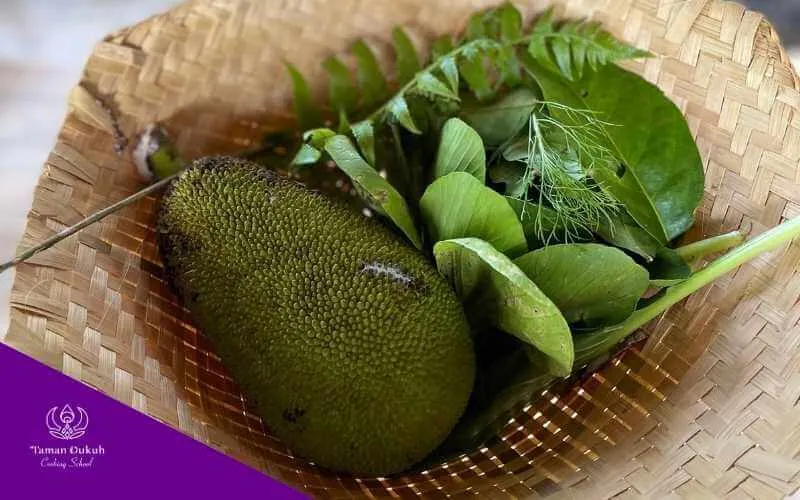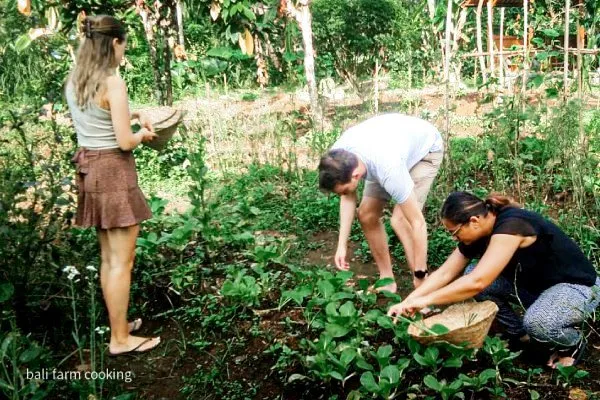Bali’s Bounty: Celebrating Fresh, Seasonal Ingredients & Flavors of the Island
Nature’s Finest, Season by Season: Unveiling the Secret to Bali’s Vibrant & Authentic Flavors!
At Taman Dukuh, we believe the most “delicious and spectacular” Balinese dishes begin with one simple, powerful principle: celebrating what nature provides, right when it’s at its absolute best!
Our commitment to using fresh, seasonal Balinese ingredients is a cornerstone of our entire farm-to-table Bali philosophy, ensuring every meal is a vibrant taste of Bali’s ever-changing bounty.
Many of our guests tell us they can “truly taste the difference” that fresh, seasonal Ubud produce makes.
It’s a “fantastic experience” to connect with the island’s natural rhythms and discover the unique flavors and ingredients that each part of the year brings to our organic farm and your cooking class plate! This is how you experience the true taste of Bali by season.
Why Seasonal Eating is at the Very Heart of Authentic Balinese Cuisine & Our Taman Dukuh Philosophy
Cooking and eating with the seasons isn’t just a trend for us; it’s a tradition deeply woven into the fabric of Balinese culture, historically rooted in practices like utilizing the produce from the pekarangan (home garden) for daily needs. This approach offers so many wonderful benefits:
- Peak Flavor, Aroma & “Amazing” Taste:
It’s simple, really. Ingredients harvested at their natural peak of ripeness are absolutely bursting with their intended flavor, aroma, and an “unforgettable” taste. Think of a sun-ripened Balinese mango in its prime versus one picked under-ripe and shipped across the world – there’s truly no comparison in terms of Bali fruit seasonality! - Maximum Nutrition & Vitality:
Seasonal produce, picked when it’s ready, is generally more nutrient-dense. It’s packed with the vitamins, minerals, and vital life force (prana, in Balinese thought) that your body loves and thrives on. This is key to healthy Balinese cooking. - Supporting Local Ecosystems & Our Cherished Farmers:
Eating seasonally supports the natural growing cycles of plants and reduces the need for energy-intensive long-distance transportation or artificial growing conditions. Crucially, it also directly benefits our local Balinese farming community, helping to sustain their livelihoods and traditional agricultural knowledge. - A Deeper Connection to Nature’s Rhythms:
Embracing seasonality allows us to appreciate the island’s natural cycles and the incredible diversity that each season brings forth. It connects us more deeply to the land and the entire seed-to-plate journey of our food. - Enhanced Sustainability & Eco-Consciousness:
Choosing seasonal and local Balinese ingredients significantly reduces the environmental impact associated with out-of-season demand (like high food miles and an increased carbon footprint). This aligns perfectly with our overarching Balinese sustainability practices and the Nyegara Gunung philosophy of environmental harmony.
Bali’s Tropical Seasons: A Year-Round Harvest with Delicious Nuances!
Being nestled in the tropics, Bali is incredibly blessed with a year-round growing season for many essential Balinese spices, herbs, and vegetables. You’ll always find something fresh and exciting!
However, the island does experience two main seasons – the Dry Season (roughly May to September) and the Wet Season (roughly October to April). These distinct periods certainly influence the abundance and prime time for certain types of produce. Here’s what that means for your plate:
- Dry Season’s Sun-Kissed Bounty:
This period often brings an abundance of incredibly sweet, sun-loving tropical fruits. Think of juicy mangoes, fragrant rambutan, smelly durian, delicate jackfruit and fresh longan. Many vegetables also thrive during this sunnier, less humid period, producing crisp and flavorful yields. This is often the best season for certain Bali fruits. - Wet Season’s Lush Gifts:
The life-giving rains bring an explosion of lush greenery and are crucial for the all-important rice cultivation cycle (padi sawah). Many exotic fruits like rambutan (with its distinctive hairy skin), mangosteen (the “queen of fruits”), and the notorious (but beloved by many!) durian often reach their peak during or just after the wet season. Certain leafy greens, tubers (umbi-umbianlike cassava and sweet potatoes), and legumes (kacang-kacangan) also flourish with the increased moisture.
The wonderful reality of Bali is that there’s almost always something delicious and fresh in season! Our organic farm team works closely and intuitively with these natural cycles to cultivate a diverse range of produce throughout the year, ensuring our Ubud cooking school always has access to the best seasonal Balinese ingredients.
A Taste of the Balinese Seasons: Examples of What We Grow & Use
While exact availability can vary year by year and even by microclimate, here are some exciting examples of the seasonal stars you might encounter on our Ubud organic farm, at the local markets during our market tours, and feature prominently in our authentic Balinese recipes: We’ve included their Balinese names for an authentic touch:
Fruits of the Island (Buah-buahan Bali):
Bali’s fruit offerings are a true feast for the senses, changing with the rhythms of nature. Some are available year-round, while others grace us with their presence only during specific seasons:
Year-Round Delights:
- Banana (
Biu): Countless varieties thrive! From small, sweet dessert bananas (likebiu susu– milk banana) to larger ones perfect for frying (pisang goreng) or steaming. Leaves are also used for wrapping. - Papaya (
Gedang): A sweet, orange-fleshed staple available anytime. Unripe ones are used as a vegetable inrujak. - Coconut (
Nyuh): The tree of life! Young coconut water (yeh kelapa muda/kuwud) is incredibly refreshing, and mature flesh is used for milk (santan) and grated in dishes. - Pineapple (
Nanas): Sweet, tangy, and juicy, generally available throughout the year. - Kaffir Lime (
Juuk Purut): Essential for its aromatic leaves and zesty juice in cooking; available year-round for seasoning. - Cucumber (
Ketimun Gantung,Ketimun Guling): Eaten raw, cooked, or inrujak; grown widely.
Dry Season Treasures (approx. May-Sep):
- Mango (
Poh,Pakel): Sweet and fragrant, peaking around August-November. Varieties likepoh gedangandpoh manalagiare local favorites. - Lychee (
Leci/Led): Small, sweet, and fragrant, with a short season typically June-July, sometimes extending to September. - Longan (
Lengkeng): Lychee’s cousin, available June-September. - Starfruit (
Belimbing): Juicy and tart, with a distinctive star shape. Fruits abundantly July-September. - Water Apple / Java Apple (
Nyambu): Crisp, light, and refreshing. Peaks July-November. - Dragon Fruit (
Buah Naga): Fruits heavily during the dry season, May-October. - Tamarillo / Tree Tomato (
Terong Belanda): Egg-shaped fruit available May-September. - Kaliasem: Cherry-like fruits popular in central Bali, season June-October.
- Kepundung: Yellowish-green round fruit, sold in bunches during the dry season (April-September).
- Salak (Salacca / Snakeskin Fruit): Distinctive taste, crisp texture. Peak season June-August, though available almost year-round from various regions or Java.
Wet Season Gems (approx. Oct-Apr):
- Rambutan (
Aceh,Buluan): Hairy skin, sweet translucent flesh. Season November-February. - Mangosteen (
Manggis): The “queen of fruits,” sweet-tart white segments. Main season January-April. - Durian (
Duren): The “king of fruits” with its potent aroma and creamy texture. Peak harvest during the rainy season, November-March. - Soursop (
Sirsak Cina,Srikaya Belanda): Creamy white flesh, sweet-tart. Harvest season March-December. - Custard Apple / Sugar Apple (
Silik,Srikaya): Sweet, soft, custard-like flesh with many seeds. Ripe beginning in September, into the early rainy season. - Avocado (
Apokat,Adpokat): Creamy and rich, with main harvests March-May and a secondary one September-November. - Passion Fruit (
Markisah): Aromatic with tangy pulp. Peak harvest November-January. - Java Plum (
Juwet): Deep purple, juicy, grape-like. Fruits early in the rainy season, November-January. - Breadfruit (
Sukun,Timbul): Starchy, cooked before eating. Has two seasons: Jan-Feb and Jul-Aug. - Cashew Apple & Nut (
Nyambu Mente/ Jambu Mete): The fruit (apple) is edible and tart; the nut is prized. Harvest November-February. - Otaheite Apple (
Kedongdong): Tangy when unripe, used inrujak. Fruits November-March.
Note: Fruit seasons in Bali can vary slightly each year depending on weather patterns and specific microclimates across the island. Some fruits like papaya, bananas, and coconuts are wonderfully available year-round!
Vegetables & Herbs from Bali’s Fertile Earth (Sayuran & Bumbu Segar):
Our farm and local markets burst with vibrant greens, root vegetables, and aromatic herbs, many of which have defined Balinese cooking for centuries. Here’s a look at what the seasons bring:
Available Year-Round (Sepanjang Tahun):
- Water Spinach (
Kangkung/Jukut Kangkung): Most popular green, grows quickly, especially Nov-Dec. - Spinach (
Bayam/Jukut Bayam): Often grown in home gardens (pekarangan). - Cassava Leaves (
Daun Singkong/Jukut Don Sela): Young leaves picked every 2-3 weeks. - Cucumber (
Ketimun Gantung/Guling): Two types, for salads or eaten raw. - Moringa (
Kelor/Jukut Klentang): “Superfood” leaves, rich in iron, grown in home gardens. - Balinese Basil (
Kemangi): Stronger aroma, picked in the morning for freshness. - Many essential herbs like Lemongrass (
Sereh), Galangal (Isen), Turmeric (Kunyit), Ginger (Jae), and Kencur (Cekuh) are perennial and harvested as needed.
Seasonal Vegetables:
- Jan-Mar (Rainy Season):
Labu Siam(Chayote / Jukut Jepang – white, crisp flesh for stir-fries),Pakis(Fern Tips / Jukut Paku – sweeter Balinese varieties from wet areas),Terung(Eggplant / Jukut Tuung – purple long varieties). - Apr-Jun (Transition Season / Pancaroba):
Kacang Panjang(Long Beans – peak at end of rains),Wortel(Carrot – smaller, sweeter Bali varieties from Bedugul),Sawi Hijau(Green Mustard – heat tolerant). - Jul-Sep (Dry Season):
Selada(Lettuce – from cool areas like Bedugul),Kubis(Cabbage – large, dense Bali varieties),Cabai Rawit(Bird’s Eye Chilies – spicier in dry season). - Oct-Dec (Early Rainy Season):
Kacang Merah(Red Kidney Beans – for porridge),Tauge(Bean Sprouts / Jukut Utik-Utik – from mung beans, grow fast in humidity),Pare(Bitter Melon – thrives as rains begin).
Special Balinese Vegetable Ingredients:
- Jan-Mar (Rainy Season):
Labu Siam(Chayote / Jukut Jepang – white, crisp flesh for stir-fries),Pakis(Fern Tips / Jukut Paku – sweeter Balinese varieties from wet areas),Terung(Eggplant / Jukut Tuung – purple long varieties). - Apr-Jun (Transition Season / Pancaroba):
Kacang Panjang(Long Beans – peak at end of rains),Wortel(Carrot – smaller, sweeter Bali varieties from Bedugul),Sawi Hijau(Green Mustard – heat tolerant). - Jul-Sep (Dry Season):
Selada(Lettuce – from cool areas like Bedugul),Kubis(Cabbage – large, dense Bali varieties),Cabai Rawit(Bird’s Eye Chilies – spicier in dry season). - Oct-Dec (Early Rainy Season):
Kacang Merah(Red Kidney Beans – for porridge),Tauge(Bean Sprouts / Jukut Utik-Utik – from mung beans, grow fast in humidity),Pare(Bitter Melon – thrives as rains begin).
Special Balinese Vegetable Ingredients:
- Belimbing Wuluh (Averrhoa bilimbi): Tart, acidic fruit used as a souring agent, replacing vinegar in many Balinese recipes. Harvested young.
From vibrant water spinach (kangkung) and sweet carrots to unique fern tips (paku), Bali’s seasons offer an ever-changing, “delicious” array of fresh vegetables and herbs.
Our Farm’s Rhythm: Your Seasonal Balinese Cooking Adventure in Ubud
When you join a Balinese cooking class at Taman Dukuh, the specific ingredients you’ll work with are often delightfully dictated by what’s currently thriving on our organic farm and available in the local Ubud markets.
This means your culinary experience is always authentically fresh, vibrant, and uniquely tied to the time of your visit! You’re truly cooking with the best of Bali’s season.
What does this mean for your class? Our “friendly and knowledgeable” Balinese chefs are experts at adapting menus and showcasing the best of each season.
You might find yourself making a zesty, vibrant mango sambal during the peak of mango season, or a hearty young jackfruit curry when this versatile ingredient is plentiful.
This adaptability is part of the “fun and educational” nature of learning authentic Balinese cooking – it teaches you to be resourceful, creative, and to deeply appreciate the gifts of each season, just as Balinese cooks have done for countless generations.
It makes every class a unique Ubud foodie experience.
Embrace Nature’s Bounty: Taste the True, Ever-Changing Essence of Bali!
Cooking and eating seasonally is a joyful and profound way to connect with the land (Tanah Bali), the vibrant culture, and the true, ever-changing flavors of Bali.
It’s about savoring ingredients when they are at their most “delicious,” nutrient-rich, and energetically potent, and appreciating the natural cycle that brings them from seed to our table.
We warmly invite you to experience this “amazing” freshness firsthand. Join us at Taman Dukuh, tour our organic farm in Ubud, and let the current season guide your culinary creations. It’s an “unforgettable experience” that will give you a deeper appreciation for the journey of your food and the incredible, ever-changing bounty of our precious island home.
Or Book Your Seasonal Balinese Cooking Experience Today!



